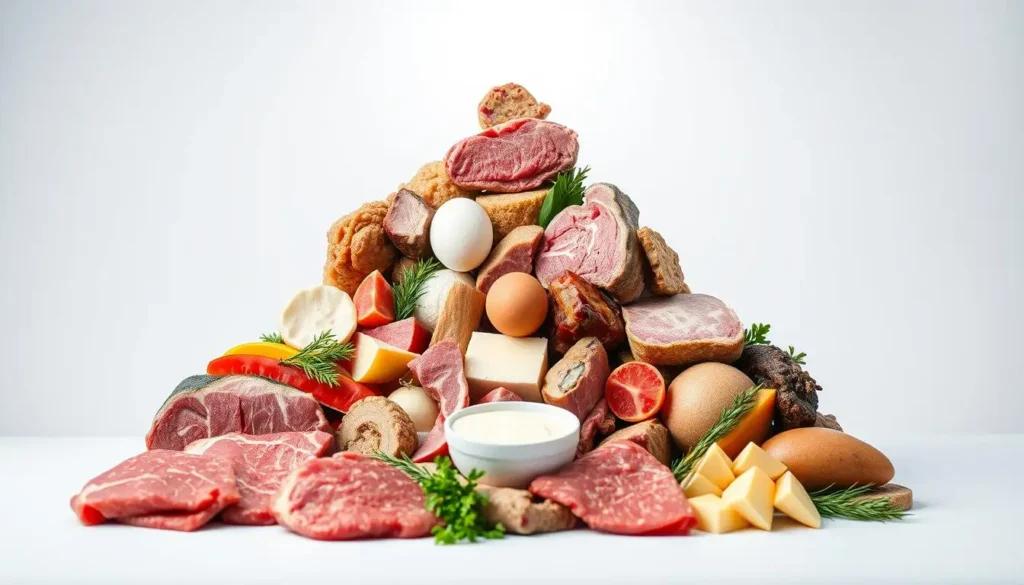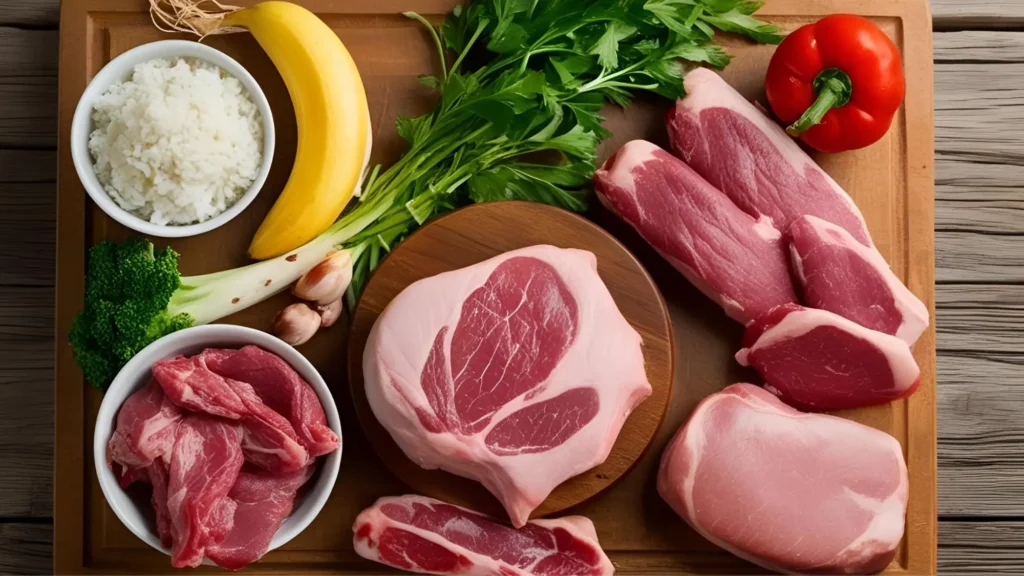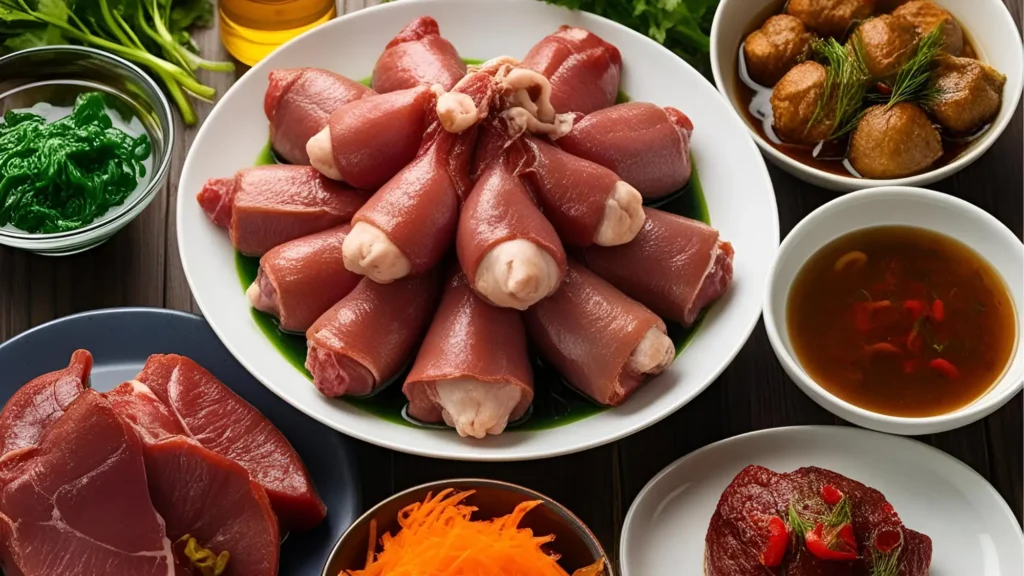Are you ready to transform your nutrition and discover a radical approach to eating that challenges everything you thought you knew about diet? The carnivore diet isn’t just another trend-it’s a revolutionary way of consuming meat-based meals that could potentially reshape your health and understanding of nutrition.
Zero carb dishes are at the heart of this dietary strategy, which focuses exclusively on animal products. By eliminating plant-based foods, followers of the carnivore diet are experiencing remarkable changes in their overall wellness. Clinical data suggests this approach can reduce weight, lower blood pressure, and improve blood sugar levels for many individuals.
In this comprehensive guide, you’ll explore a world of delicious carnivore diet recipes that make this eating style not just sustainable, but genuinely enjoyable. Whether you’re a curious newcomer or a committed meat enthusiast, these insights will equip you with the knowledge to master meat-based nutrition.
Key Takeaways
- Carnivore diet focuses exclusively on animal products
- Potential health benefits include weight loss and improved metabolic markers
- Diverse and delicious meat-based meals are key to diet success
- Zero-carb approach challenges traditional nutritional guidelines
- Proper recipe knowledge ensures diet sustainability
Understanding the Fundamentals of the Carnivore Diet
The carnivore diet represents a radical approach to nutrition that challenges traditional dietary guidelines. By focusing exclusively on animal protein recipes, this primal food preparation method strips away plant-based foods and concentrates on nutrient-dense animal products.

Your journey into keto carnivore cuisine begins with understanding the core principles that make this dietary approach unique. Unlike mainstream nutritional recommendations, the carnivore diet emphasizes consuming only animal-based foods.
The Science Behind Animal-Based Nutrition
Animal proteins provide a complete nutritional profile that includes:
- Essential amino acids
- High-quality protein
- Bioavailable nutrients
- Zero carbohydrate content
Key Benefits of Going Carnivore
Practitioners of the carnivore diet report numerous potential advantages, such as:
- Enhanced mental clarity
- Improved metabolic health
- Decreased inflammation
- Simplified meal planning
Common Misconceptions Debunked
Many people misunderstand the carnivore diet. It’s not just about eating meat – it’s a strategic approach to nutrition that prioritizes animal-based nutrient absorption and metabolic optimization.
The carnivore diet challenges conventional nutritional wisdom by demonstrating that humans can thrive on an animal-exclusive diet.
Getting Started with Your Carnivore Journey
Embarking on a carnivorous meal plan requires careful preparation and understanding. Your journey into the world of high-fat animal foods starts with strategic planning and a clear approach to nutrition.
To begin your meatarian diet ideas exploration, consider these essential first steps:
- Calculate your protein requirements based on body weight
- Select premium quality animal proteins
- Gradually transition from your current diet
- Develop a sustainable carnivorous meal plan
Protein intake is crucial for carnivore diet success. Most nutritionists recommend 0.8 to 1 gram of protein per kilogram of body weight. This means a 180-pound individual would aim for approximately 65-80 grams of protein daily.
Pro tip: Listen to your body and make adjustments as you adapt to high-fat animal foods.
When shopping for your carnivore diet, focus on diverse protein sources like:
- Grass-fed beef
- Pasture-raised chicken
- Wild-caught fish
- Organ meats
Your initial weeks might challenge you, but staying committed to your meatarian diet ideas will help you navigate potential adaptation difficulties. Remember that individual experiences vary, so patience is key.
Essential Kitchen Equipment for Carnivore Cooking
Transforming your kitchen into a paleo carnivore cooking powerhouse requires strategic equipment selection. The right tools can make your carnivore diet plan pdf implementation smooth and enjoyable.

Preparing for a successful carnivore diet means investing in quality kitchen tools that support your nutritional goals. Your cooking arsenal will determine the quality and variety of meals you can create.
Must-Have Tools and Appliances
- Cast iron skillet for perfect meat searing
- High-quality chef’s knife
- Meat thermometer for precise cooking
- Sous vide machine for consistent recette keto carnivore preparations
- Heavy-duty cutting board
Storage Solutions for Bulk Meat
Proper meat storage is crucial for maintaining freshness and preventing waste. Consider investing in:
- Vacuum sealer for long-term freezer storage
- Large chest freezer
- Airtight containers for refrigerated meats
- Portion-sized freezer bags
Temperature Control Essentials
Food safety is paramount in carnivore cooking. Maintain proper temperatures using reliable tools that help you track and control meat preparation.
- Digital instant-read thermometer
- Refrigerator/freezer temperature monitors
- Cooling racks for resting meats
By equipping your kitchen with these essential tools, you’ll be prepared to create delicious, nutrient-dense meals that support your carnivore lifestyle.
How to prepare the best steak recipe
Sourcing Quality Meats for Your Diet
Selecting the right meats is crucial for any carnivore diet coach working with clients seeking optimal nutrition. Your meat choices can dramatically impact the quality of your diet and overall health. Grass-fed and pasture-raised meats offer superior nutritional profiles compared to conventional options.

When searching for high-quality meats, consider these key sources:
- Local farmers markets
- Specialty butcher shops
- Direct farm purchases
- Online meat delivery services
“The quality of your meat determines the quality of your carnivore diet” – Nutrition Experts
For those exploring keto carnivore français cuisine, prioritize these protein sources:
- Beef from grass-fed cattle
- Pasture-raised chicken
- Wild-caught fish
- Organic pork
Your egg pudding carnivore recipes will shine brightest when using fresh, organic eggs from free-range chickens. Building relationships with local farmers can help you access the most nutrient-dense meats available.
Remember to inspect meat quality by checking for:
- Color and texture
- Fat marbling
- Organic certification
- Farming practices
Investing time in sourcing premium meats transforms your carnivore diet from basic nutrition to a sophisticated health strategy.
Basic Carnivore Diet Recipes for Beginners
Embarking on the carnivore diet can feel challenging, but with the right recipes, you’ll quickly discover delicious and simple meal options. Many carnivore success stories highlight the importance of starting with easy, nutritious recipes that make the transition smooth and enjoyable.
Your journey into carnivore cooking begins with mastering a few fundamental techniques that will transform your meal preparation. Let’s explore some beginner-friendly recipes that will make your dietary transition both tasty and sustainable.
Simple Steak Preparations
Cooking the perfect steak is an art that every carnivore diet enthusiast should master. Here are some foolproof methods:
- Salt-and-sear method for maximum flavor
- Cast-iron skillet technique
- Reverse searing for even cooking
Quick Ground Beef Dishes
Ground beef offers versatility for your carnivore meal plan. Try creating gaufre keto carnivore-style dishes that are both satisfying and simple to prepare.
- Classic seasoned ground beef patties
- Carnivore waffles using ground beef, eggs, and salt
- Quick beef scrambles
Easy Organ Meat Introductions
Organ meats are nutritional powerhouses that can seem intimidating to beginners. Start with mild-flavored options like chicken liver or beef heart, seasoned simply with salt to ease into these nutrient-dense foods.
Remember, your carnivore diet journey is personal. Experiment with these recipes, listen to your body, and enjoy the process of discovering new, delicious ways to nourish yourself.
Advanced Carnivore Cooking Techniques
Elevating your carnivore diet cooking skills requires mastering advanced techniques that transform simple ingredients into culinary masterpieces. Whether you’re preparing simple carnivore diet chicken recipes or experimenting with complex meat preparations, professional cooking methods can significantly enhance your meal experience.
Professional chefs recommend several key techniques for perfecting carnivore-friendly dishes:
- Sous vide cooking for precise temperature control
- Dry-aging meats at home for enhanced flavor
- Smoking techniques for rich, deep taste profiles
- Butter basting to create luxurious texture
For those interested in simple carnivore chicken breast recipes, understanding proper cooking methods is crucial. Precision matters when preparing protein-rich meals. Invest in quality kitchen tools like meat thermometers and cast-iron skillets to ensure consistent results.
A carnivore chicken casserole can be transformed from basic to extraordinary by implementing advanced cooking techniques. Techniques like slow roasting and using bone marrow as a natural flavor enhancer can elevate your dish without introducing plant-based seasonings.
Professional tip: Always let your meat rest after cooking to preserve maximum juiciness and flavor.
By mastering these advanced cooking methods, you’ll create restaurant-quality meals that make your carnivore diet both nutritious and enjoyable.
Creative Carnivore Diet Recipes
Exploring innovative ways to enjoy animal-based nutrition can transform your carnivore diet experience. These creative recipes push culinary boundaries while keeping true to the core principles of meat-focused eating.
When diving into carnivore cooking, you’ll discover exciting possibilities that go beyond traditional meat preparations. From unique protein-packed snacks to unexpected dish variations, these recipes will keep your meals interesting and nutritionally dense.
Beef Liver Pâté Variations
Beef liver pâté offers an incredible nutrient boost for carnivore dieters. A classic preparation involves:
- High-quality grass-fed beef liver
- Grass-fed ghee or butter
- Sea salt to taste
- Optional: fresh herbs for enhanced flavor
“Organ meats are nature’s multivitamin” – Carnivore Diet Experts
Carnivore Waffles and Pancakes
Transform your carnivore whole chicken recipe into unique breakfast options. Keto chicken recipes can be adapted to create innovative carnivore chicken thigh recipe-based waffles using ground chicken, eggs, and minimal additional ingredients.
Meat-Based Snacks
Keep your energy levels stable with protein-rich snacks. Consider creating:
- Crispy chicken chips
- Beef jerky rolls
- Liver crisps
- Egg-based protein bites
These creative recipes demonstrate that the carnivore diet can be both nutritious and exciting, offering endless culinary possibilities for meat enthusiasts.
Organ Meat Delicacies and Preparations
Diving into organ meats can transform your carnivore diet experience. These nutrient-dense powerhouses offer a unique approach to nutrition that goes beyond traditional muscle meats. While some people might feel hesitant, organ meats provide an incredible range of vitamins and minerals that can supercharge your health.

When preparing organ meats for your carnivore diet, consider these key strategies:
- Start with mild-tasting organs like chicken liver
- Use shredded chicken techniques to incorporate organ meats seamlessly
- Experiment with different cooking methods to enhance flavor
Your carnivore diet can benefit dramatically from organ meat integration. Liver, heart, and kidney are particularly rich in essential nutrients like vitamin A, B vitamins, and iron. These meats can help optimize your nutritional intake while providing diverse protein sources.
Popular preparation methods include:
- Pâté creation
- Gentle pan-searing
- Blending into ground meat dishes
- Making crispy organ meat “chips”
Pro tip: Always source high-quality, grass-fed organ meats to maximize nutritional benefits.
By embracing organ meats in your carnivore diet, you’ll unlock a world of nutritional potential that traditional muscle meats alone cannot provide.
Bone Broth and Collagen-Rich Recipes
Unlock the powerful nutrition of bone broth in your carnivore diet recipes. These meat-based meals provide an exceptional way to boost your nutritional intake with zero-carb dishes that support overall health and wellness.
Bone broth stands as a nutritional powerhouse for those following a carnivore diet. Packed with essential minerals, amino acids, and collagen, this liquid gold can transform your meat-based meals into healing elixirs.
Traditional Bone Broth Techniques
Creating the perfect bone broth requires careful selection and preparation. Your bone broth journey starts with high-quality animal bones:
- Select grass-fed beef bones or free-range chicken bones
- Choose a mix of marrow and joint bones for maximum nutrition
- Roast bones before simmering to enhance flavor
- Slow cook for 24-48 hours to extract maximum nutrients
Gelatin-Rich Preparations
Carnivore diet recipes can incorporate gelatin-rich preparations that provide additional nutritional benefits. These zero-carb dishes offer a unique way to consume essential proteins and support joint health.
- Create meat jellies using bone broth and gelatin
- Develop savory aspics with minimal ingredients
- Use gelatin as a natural thickener in meat-based meals
By integrating bone broth and collagen-rich recipes into your carnivore diet, you’ll enhance your nutritional profile while enjoying delicious, healing meals.
Meal Prepping on the Carnivore Diet
Meal prepping is a game-changer for anyone following a keto carnivore cuisine lifestyle. By planning your animal protein recipes in advance, you can save time, reduce stress, and stay committed to your primal food preparation goals.
Your carnivore diet meal prep strategy should focus on efficiency and nutritional variety. Start by selecting high-quality meats that can be easily portioned and stored. Consider these key steps:
- Purchase meats in bulk from trusted local sources
- Invest in quality food storage containers
- Cook multiple protein cuts simultaneously
- Use vacuum sealing for extended freshness
When preparing your meals, rotate between different protein sources to ensure balanced nutrition. Grass-fed beef, wild-caught fish, and organ meats can provide a diverse range of nutrients while keeping your meals interesting.
Temperature control is crucial for maintaining meat quality. Always cool cooked meats quickly and store them at proper refrigeration temperatures. Most prepared carnivore diet meals can safely remain refrigerated for 3-4 days.
Pro tip: Label your prepared meals with the date of preparation to track freshness and prevent food waste.
By mastering meal prepping, you’ll streamline your carnivore diet journey, ensuring you always have nutritious, delicious meals ready to support your health and fitness goals.
Special Occasion Carnivore Recipes
Staying true to your carnivorous meal plans during special occasions doesn’t mean sacrificing flavor or tradition. Your meatarian diet ideas can shine brilliantly at holiday gatherings and celebrations, proving that high-fat animal foods can be both delicious and impressive.
Navigating social events while maintaining a carnivore diet requires creativity and confidence. The key is to focus on premium meat selections that become the centerpiece of any festive meal.
Spectacular Holiday Meat Dishes
When planning your carnivore-friendly celebration, consider these show-stopping protein options:
- Prime rib roast with herb-infused beef tallow
- Rack of lamb with garlic and rosemary rub
- Whole roasted duck with crispy skin
- Porterhouse steak for large gatherings
Celebration Roast Strategies
Transform your high-fat animal foods into memorable meals by mastering these techniques:
- Select top-quality, grass-fed meats
- Use precise temperature control
- Season generously with salt and pepper
- Allow proper resting time after cooking
Pro tip: Always have a meat thermometer to ensure perfect doneness and impress your guests with professional-level cooking skills.
Carnivore Diet Recipes for Weight Loss
Losing weight on a carnivore diet isn’t just about cutting calories. It’s about strategic paleo carnivore cooking that maximizes nutrition and satiety. Your body can transform when you focus on high-quality, nutrient-dense animal proteins.
The key to successful weight loss with a carnivore diet plan pdf approach involves selecting the right meat selections and cooking techniques. Lean proteins like chicken breast, turkey, and grass-fed beef become your primary tools for reducing body fat while maintaining muscle mass.
- Choose fatty cuts for longer satiety
- Prioritize grass-fed and pasture-raised meats
- Use minimal cooking oils
- Practice portion control
Implementing recette keto carnivore strategies can help you create meals that keep you full and energized. Ground beef scrambles, slow-cooked roasts, and organ meat preparations provide essential nutrients while supporting your weight loss goals.
Weight loss is not just about eating less, but eating smarter with nutrient-rich animal proteins.
Your carnivore diet weight loss journey requires understanding macronutrient balance. Focus on high-protein, moderate-fat meals that support metabolism and reduce overall calorie intake without sacrificing nutritional density.
Incorporating Seafood into Your Carnivore Diet
Expanding your carnivore diet with seafood can unlock a world of nutritional benefits and flavor profiles. As a carnivore diet coach, I recommend integrating high-quality fish and shellfish to enhance your meal plan’s diversity and nutrient density.
Seafood offers unique nutritional advantages for those following a strict animal-based eating approach. The omega-3 fatty acids and essential minerals found in fish can complement your existing protein intake.
Selecting Premium Seafood Options
- Wild-caught salmon
- Fresh sardines
- Mackerel
- Oysters
- Shrimp
Simple Seafood Preparation Techniques
When preparing seafood for your keto carnivore français inspired meals, focus on simple cooking methods that preserve nutrients. Grilling, poaching, and pan-searing are excellent techniques that maintain the fish’s natural flavors.
Try creating an egg pudding carnivore-style by incorporating fresh fish or shellfish for added protein and rich texture. Aim to source high-quality, fresh seafood from reputable suppliers to ensure optimal nutrition and taste.
Pro tip: Always choose wild-caught seafood over farm-raised when possible to maximize nutritional benefits.
Seafood can be a delicious and nutrient-dense addition to your carnivore diet strategy, offering variety and essential nutrients that support your health goals.
Budget-Friendly Carnivore Meal Planning
Embracing the carnivore diet doesn’t mean breaking the bank. Smart meal planning can transform your nutrition without overwhelming your wallet. Many carnivore success stories demonstrate that strategic shopping and preparation can make this diet both affordable and sustainable.
Your budget-friendly carnivore journey starts with intelligent meat purchasing strategies. Consider these cost-effective approaches:
- Buy meat in bulk from local farmers or wholesale suppliers
- Purchase less expensive cuts like chuck roast and chicken thighs
- Explore community-supported agriculture (CSA) programs
- Freeze meat to extend its usability
Creativity can elevate budget meats into delicious meals. Carnivore waffles made from ground beef or gaufre keto carnivore recipes can turn inexpensive ingredients into exciting culinary experiences. Slow cooking tough cuts transforms them into tender, flavorful dishes that are both economical and satisfying.
Reducing food waste is crucial for budget-conscious carnivore dieters. Learn to use every part of the animal, from organ meats to bone broth. These nutrient-dense options are often cheaper and packed with essential minerals and vitamins.
Pro tip: Local butchers often offer discounts on bulk purchases or less popular meat cuts.
With careful planning and smart shopping, you can enjoy a nutritious carnivore diet without straining your finances.
Traveling While Following the Carnivore Diet
Maintaining your carnivore diet while traveling can be challenging, but with the right preparation, you can stick to your nutritional goals. Strategic planning is key to ensuring you have access to carnivore-friendly meals during your journey.
When preparing for travel, consider packing some essential carnivore diet staples. Portable protein sources like simple carnivore diet chicken recipes can be your best companion. Vacuum-sealed simple carnivore chicken breast recipes work perfectly for road trips or flights. You might want to pack:
- Pre-cooked carnivore chicken casserole
- Dried meat strips
- Canned fish
- Portable protein powder
Restaurant navigation requires clear communication. When dining out, explain your dietary needs to servers. Request plain grilled meats without sauces or seasonings. Many restaurants can accommodate simple protein preparations, especially steakhouses and seafood restaurants.
Hydration remains crucial during travel. Carry electrolyte supplements specifically designed for carnivore diet followers. These help maintain your body’s mineral balance when your typical eating routine is disrupted.
Pro tip: Always research local restaurants and grocery stores at your destination that offer carnivore-friendly options.
International travel might present more challenges, but adaptability is key. Learn basic phrases in the local language to explain your dietary requirements. Many cultures have meat-centric cuisines that can easily support your carnivore lifestyle.
Conclusion
Your exploration of the carnivore diet represents more than just a nutritional choice—it’s a transformative approach to health and wellness. From mastering carnivore whole chicken recipes to experimenting with keto chicken recipes, you’ve discovered a world of culinary possibilities that can potentially improve your metabolic health.
Each carnivore chicken thigh recipe you’ve learned demonstrates the diet’s versatility and potential benefits. Research suggests promising outcomes for weight management, blood pressure reduction, and blood sugar control. By carefully selecting high-quality meats and understanding cooking techniques, you can create delicious meals that support your wellness goals.
Remember that nutrition is deeply personal. While the carnivore diet offers intriguing potential, it’s crucial to listen to your body and consult healthcare professionals. Your individual response matters most. Continue exploring recipes, refining your approach, and staying informed about nutritional science to make the most of this dietary strategy.
As you move forward, approach the carnivore diet with curiosity, flexibility, and an open mind. Your journey is unique, and the skills you’ve gained will empower you to make informed dietary choices that align with your health objectives.
FAQ
What exactly is the carnivore diet?
The carnivore diet is an extreme dietary approach that consists of eating exclusively animal products, eliminating all plant-based foods. It typically includes meats, fish, eggs, and some dairy products, focusing on consuming high-quality animal proteins and fats while completely avoiding fruits, vegetables, grains, and other plant-based foods.
Is the carnivore diet safe for long-term consumption?
While some people report positive health benefits, the long-term safety of the carnivore diet is still being researched. It’s crucial to consult with a healthcare professional before starting this diet, as it may lack certain essential nutrients found in plant-based foods. Potential risks include nutrient deficiencies, increased cholesterol, and disrupted gut microbiome.
How do I start the carnivore diet?
Begin by gradually transitioning from your current diet. Start by eliminating plant-based foods and introducing more animal proteins. Focus on high-quality, grass-fed meats, wild-caught fish, and pasture-raised eggs. It’s recommended to begin with familiar meats and slowly incorporate organ meats. Stay hydrated and listen to your body during the transition.
What are the potential benefits of the carnivore diet?
Reported benefits include weight loss, improved mental clarity, reduced inflammation, stabilized blood sugar levels, and increased energy. Some individuals claim improvements in autoimmune conditions, digestive issues, and overall health. However, scientific research is still limited, and individual results can vary significantly.
What meats are best for the carnivore diet?
Opt for high-quality, nutrient-dense meats such as grass-fed beef, pasture-raised chicken, wild-caught fish, lamb, and organ meats like liver and heart. Prioritize fatty cuts of meat and include a variety of protein sources to ensure nutritional diversity. Avoid processed meats with added chemicals or preservatives.
How do I handle social situations while on the carnivore diet?
Prepare in advance by eating before social events or bringing your own carnivore-friendly foods. When dining out, opt for steakhouses or restaurants with extensive meat options. Be confident in your dietary choices and have pre-prepared explanations ready. Consider carrying portable meat snacks for unexpected situations.
Can I lose weight on the carnivore diet?
Many people experience weight loss due to the diet’s high protein and fat content, which can increase satiety and reduce overall calorie intake. The elimination of carbohydrates may also contribute to rapid weight loss. However, individual results depend on total calorie consumption, activity level, and metabolic factors.
Are supplements necessary on the carnivore diet?
While the diet aims to provide complete nutrition through animal products, some individuals might benefit from supplements like electrolytes, vitamin D, and omega-3 fatty acids. Consult with a healthcare professional to determine your specific nutritional needs and potential deficiencies.
How expensive is the carnivore diet?
The diet can be costly, especially when choosing high-quality, grass-fed, and organic meats. To reduce expenses, buy in bulk, choose less expensive cuts, develop relationships with local farmers, and consider purchasing whole animals. Meal prepping and freezing can also help manage costs effectively.
What should I do if I experience side effects?
Some initial side effects like digestive changes, fatigue, or “keto flu” symptoms are common during the transition. Stay hydrated, ensure adequate electrolyte intake, and give your body time to adapt. If severe symptoms persist, consult a healthcare professional and consider modifying your approach to the diet.


1 thought on “Mastering The Carnivore Diet: Essential Recipes You Need To Try”